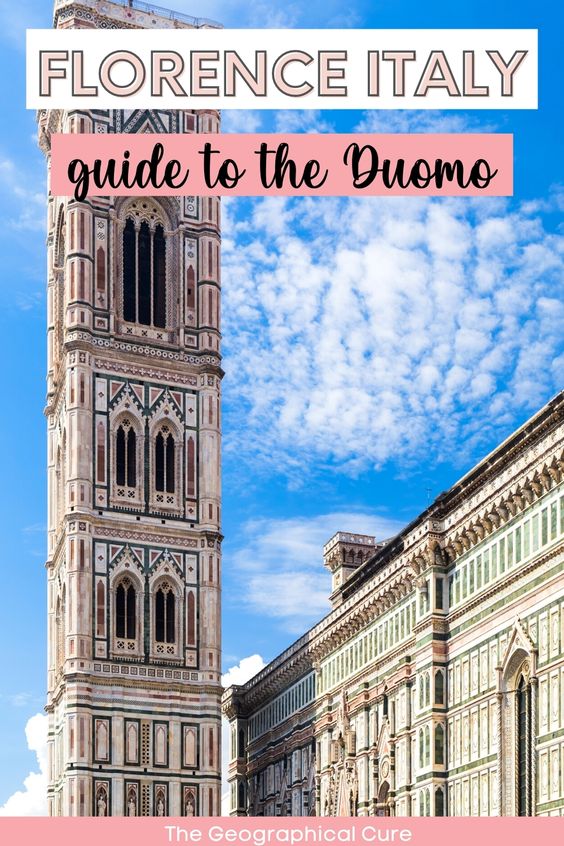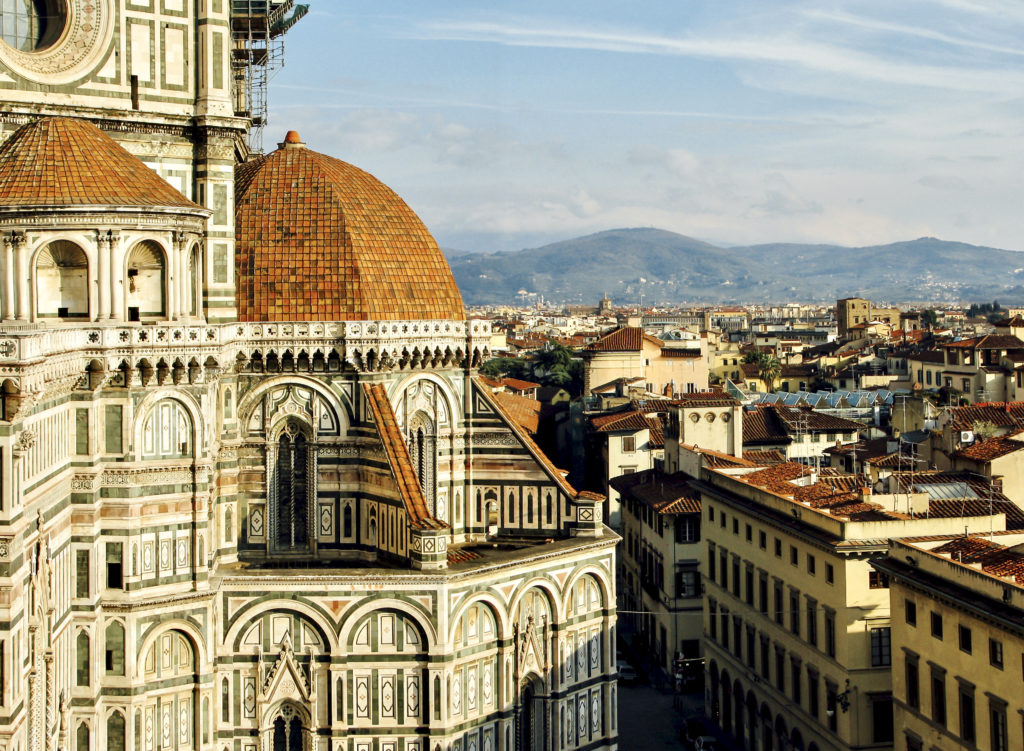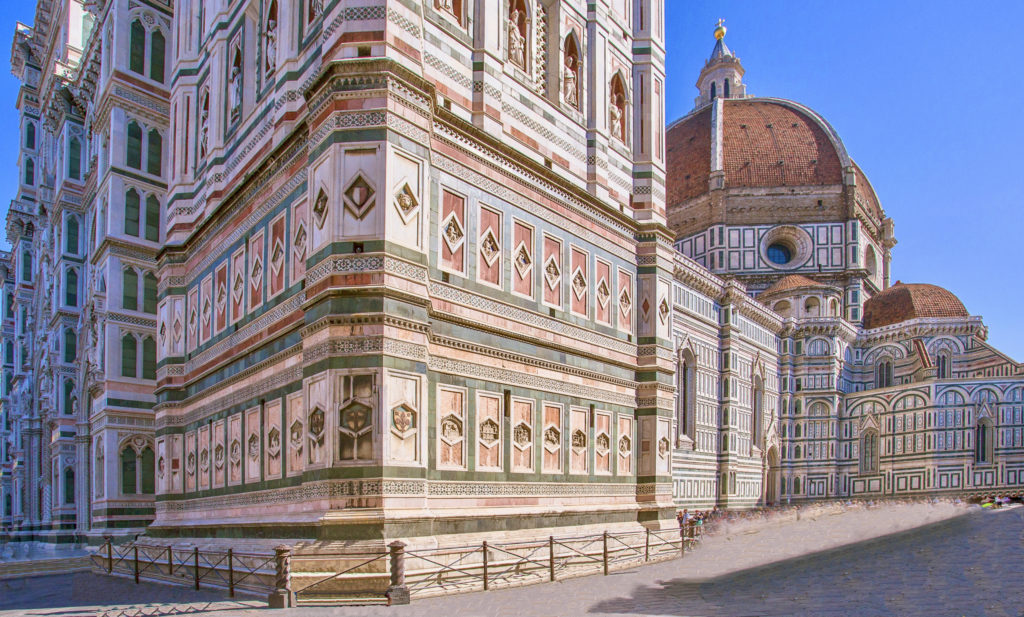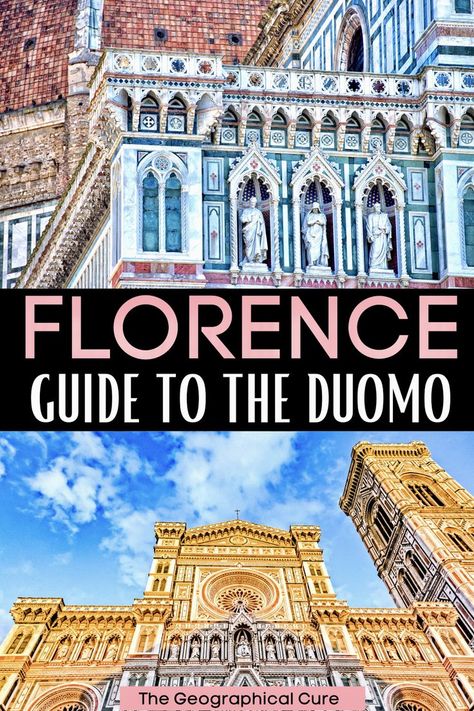Florence Cathedral, also known as the Duomo di Firenze and Cattedrale di Santa Maria del Fiore, is one of the world’s most iconic cathedrals.
Visiting this architectural wonder is an immersive experience. You can admire the stunning facade, stroll through the cathedral interior, and hike up the stairs to Brunelleschi’s dome for stunning views.
In this guide, I tell you everything to know to have the best visit — a mini history of the Duomo, everything to see, how to get skip the line tickets, and how to climb Brunelleschi’s iconic dome.
This guide will help you have an efficient visit to the Duomo, which is the very symbol of Florence.
Overview of the Duomo
Nicknamed the Duomo, Florence Cathedral is the most prominent, and popular, landmark in Florence. Duomo doesn’t mean dome.
The word Duomo is a nickname for a cathedral, combining Latin words that translate as house of God.

The Duomo was built over 172 years, beginning in 1296. The Commune of Florence hired architect Arnolfo di Cambio, a man responsible for building much of 13th and 14th century Florence.
Florence Cathedral is nicknamed the Duomo. It’s also called the Cathedral of Santa Maria della Fiore, or St. Mary of the Flowers.
There was no such saint in real life. But Florence, or Firenze, means lily flower. So the city cathedral took on the symbol of Florence.

Tickets & Tours Of Florence Cathedral
You have to be organized to visit the Duomo and climb the dome. It’s an exceedingly popular activity.
You may want to book a guided tour of the Duomo itself. You can also book a guided tour that includes access to the dome and secret terraces that you wouldn’t see on a regular visit.
It’s absolutely essential to pre-book a ticket to climb Brunelleschi’s dome.
You can also book a combination guided tour for the Baptistery, Duomo Museum and a dome climb. This 3 hour combination guided tour covers the four attractions I’ve just mentioned, plus Giotto’s bell tower.
Guide To Florence Cathedral: What To See
Here’s what you can’t miss at Florence’s Duomo:
1. Architecture
Arnolfo di Cambio was the original architect who got the project off the ground. The patron was the Commune or the city of Florence.
There was a pre-existing church on sit, Santa Reparata. The citizens weren’t that excited about demolishing it. So Arnolfo built his church around the older church.
The first part that went up was the brownstone facade. Then, Arnolfo built the walls around the older church. The old church would remaining standing for 100 years. Finally, when the original protestors were long gone, the Florentines tore it down.
Florence Cathedral is Gothic in style. But not in the light and elegant way you think of France’s Notre Dame or Chartres.
The cathedral is made of pietra forte, brown sandstone. The sandstone was beautifully faced with pink marble (from Tuscany), green marble (from Prato), and white (from Carrera) marble.
2. Facades
The Duomo relies, for its first dazzling effect on its jaw dropping facade. The Duomo has two marble facades, one from the 14th century (on the sides) and one from the 19th century (the front).
The 14th century facade was designed by Andrea Orcagna and Taddeo Gaddi. There’s an intense amount of Gothic detailing and copies of early Renaissance sculptures (originals are in the Duomo Museum).
READ: Guide To Florence’s Duomo Museum
The original 14th century facade on the front, built by Arnolfo di Cambio, was taken down in the 1587. It was considered outdated. The city wanted a Renaissance facade.
Unfortunately, due to corruption and scandal, a new Neo-Gothic facade wasn’t rebuilt until the 19th century. In the interim, for 300 years, the front facade was just raw brownstone.
In the Duomo Museum, you can see a giant reconstruction of Arnolfo’s facade that was torn down, along with the statues that once adorned it.
The 19th century facade is an extravaganza of Neo-Gothic decoration, too much to even try to describe. It has a large Rose window and smaller Rosette windows.
There are three main doors, or portals. The portals have lunettes with architraves and mosaic decoration.
The main portal has over-the-top Gothic decoration with Mary, saints, popes, and trumpeters. On both sides of the bronze doors in tabernacles are statues of the Florence’s patron saints: St. Reparata on the left and St. Zenobius on the right.
For awhile, Florence Cathedral was the largest church in the world. But, then St. Peter’s Basilica in Rome, blew it away.
3. Facade Sculptures
On the original 14th century facade, the sculptures were created by the greatest artists of the day — Arnolfo di Cambio, Donatello, and Nanni di Banco. The sculptures reflect the transition from the Gothic to the early Renaissance style. If you want to see these statues in person, the original works are now in the Duomo Museum.
The sculpture in the middle of the reconstructed facade is Arnolfo’s famous Madonna With the Glass Eyes, dating from around 1300. It’s one of the most famous sculptures in history. Arnolfo introduced naturalism and paid attention to anatomy, unlike the prior Byzantine style.
And, of course, Michelangelo’s David was originally intended to be set atop the Duomo. But it was deemed too beautiful. Instead, David was placed at the entrance of Palazzo Vecchio. Now, it’s in the Accademia Gallery.
On the Duomo’s 19th century facade, there’s a long row of tabernacles containing sculptures of Mary and Jesus and the 12 apostles. It’s right under the rose window.
Above that, between the rose window and the tympanum, there’s a gallery with busts of famous Florentine artists.
4. Giotto Bell Tower
In 1334, the Commune decided to add the bell tower. They hired Giotto, the most famous painter of the 14th century. Giotto was pretty old by this time. He died 3 years later in 1337. He may not have had much real input.
Then, Florence hired Nicola Pisano, who designed the earliest set of the Baptistery bronze doors. But he was dismissed two years later.
READ: Guide To the Florence Baptistery
Then, Francesco Talenti was hired. He finished the project in two years flat. For his dispatch, he was named head architect of the cathedral.
When you look at the bell tower, you can see the different architects at work. Talenti likely did levels 5-7.
On a Giotto Campanile climb, you have Florence’s best views of the Duomo and Brunelleschi’s dome.
There are no elevators though, and it’s 414 steps to the top. The lines can sometimes be quite long.
READ: Best Views in Florence
5. Interior
While Florence Cathedral is elegantly and intricately “frosted” with colored marble on the outside, inside Florence Cathedral is austere and almost empty. You might even wonder if it was ever finished.
Talenti was responsible for the interior decoration. Talenti was an “architect’s architect.” He wanted the decoration to be minimal to emphasize the architecture. There’s geometric proportion and a few pointed arches.
The octagonal crossing space is vast, 143 feet across with large bays. There’s no real transept space. There are five radiating chapels.
There are two important frescos painted by Paolo Uccello and Andrea del Castagno —Condottiero Giovanni Acuto and Niccolò da Tolentino. And a sculpture of Brunelleschi by Andrea Cavalcanti.
You can also visit the cathedral’s crypt, where you will find the ruins of Santa Reparata.
6. Brunelleschi’s Dome
Filippo Brunelleschi’s magnificent terra cotta colored dome, built from 1420-36, is the highlight of Florence Cathedral.
It’s a true Renaissance masterpiece and wonder of pre-industrial engineering. When it began building the Duomo, Florence knew it lacked the requisite technology to complete the dome.
Before Brunelleschi came along, the Duomo lay open for well over a century. But Brunelleschi was the perfect balance of architect and engineer, visionary and traditionalist.
Brunelleschi developed a “dome within in a dome” double shell concept that worked without wooden centering. Financed by Cosimo de Medici (the Elder), it catapulted the Medici name forward in Florentine society.
Brunelleschi’s dome was over a foot wider than the Pantheon in Rome. That was intentional; size mattered. It’s still the largest brick dome ever built, all 4 million bricks of it.
7. Climbing Brunelleschi’s Dome
If you need to burn off some pasta carbs, climb the 463 steps to the top of Brunelleschi’s dome.
It’s one of the best things to do in Florence. When you make the climb, you’re between the two domes Brunelleschi designed.
But be forewarned, it’s very tight. The narrow twisting corridor gets clogged.
It can be hot, stuffy, and potentially claustrophobic. And there’s no elevator. If you’re doing the dome climb in the summer, it will be stifling.
8. Vasari’s The Last Judgment
About 2/3 of the way up is a viewing ledge at the base of the drum. From here, you have a splendid view of Giorgio Vasari’s dome fresco of The Last Judgment, painted from 1572-79.
The fresco was cleaned and restored in 1996. It’s a bit hard to get a good photo because the viewing area is covered by netting.
Covering some 3,6000 square meters, the fresco is the largest one in the world. Originally, Brunelleschi wanted his dome covered in gold mosaics like the Baptistery. But that plan was never realized, probably because it was too costly.
READ: Guide To the Art of Giorgio Vasari
120 years after Brunelleschi’s death, Giorgio Vasari was commissioned by Cosimo I to fresco the dome. The Last Judgment is divided in to five zones.
Enthroned in the center is Christ the judge. The various levels separated by bands show the other players in the drama — the elders of the apocalypse, saints, member of the Medici family, and the damned in hell.
In their monumentality, the figures floating against the background of heaven are reminiscent of those of Michelangelo, who Vasari revered. Michelanglo’s The Last Judgment in the Sistine Chapel was Vasari’s inspiration.
READ: The Michelangelo Guide to Florence
Back inside the dome, the climb gets progressively more challenging. The magnificent panoramic view from the top is worth the discomfort though. You can see all of Florence and some of the Tuscan countryside.
Practical Guide & Tips For Florence Cathedral
Here are some other tips for visiting the Duomo.
How To Get Tickets For the Duomo and Brunelleschi’s Dome
So, now to the nitty gritty details. What’s the best way to get tickets for the Duomo and Brunelleschi’s dome?
Right now, you can buy individual tickets to the different Duomo attractions. Or you can buy a combination ticket on the website.
I recommend the Brunelleschi Pass. You can also book the Giotto Pass, but that doesn’t give you dome access.
The current individual fees are: (1) Brunelleschi’s dome € 20; (2) Giotto Bell Tower € 15; and (3) Baptistery and Duomo Museum € 10.
You can try to buy your tickets in person in Florence and try to reserve a dome climb entry time. But they could be sold out.
Go to either the main Duomo ticket office (facing the Baptistery) or at a ticket machine in the Duomo Museum lobby.
The dome climb is ONLY possible with an advance reservation and ticket. You can book a time slot when you purchase your combination ticket online. Dome climb time slots can fill up weeks in advance in high season, so reserve well ahead.
I would only do the dome climb if you’re in pretty decent physical health and don’t suffer from any claustrophobia.

Once you’ve made the reservation, you can’t change it. Show up 20-30 minutes early.
The entrance for the dome climb is on the north side of the Duomo at Porta della Mandorla. If you are more than 5 minutes late for your designated time, you won’t be let in.
Note that entrance to the Duomo itself is free. But, without the pass, you will encounter long lines.
Generally, I’d say that, if you’re pressed for time, it’s not essential to wait to go inside the cathedral. The interior is rather underwhelming compared to the eye catching exterior.
How To Plan Your Visit To the Duomo Sites
To help plan your visit to the complex, here are the time schedules of the Duomo sites.
They all open and close at different times. Check the specific website because sometimes hours change.
- Duomo: 10:00 am to 4:30 pm
- Brunelleschi’s Dome: 8:30 am to 5:00 pm
- Giotto Bell Tower | Campanile: 8:15 am to 10:15 am & 11:15 am to 7:30 pm
- Crypt: 10:00 am to 4:30 pm
- Duomo Museum: 9:00 am to 7:00 pm (but closed Sunday afternoon)
- Baptistery: 8:15 am to 6:30 pm
To budget your time in the best way, I would start with the Baptistery at 8:15 am, move on to the Duomo Museum, and then have a bell tower climb scheduled for 11:00 am or so.
Don’t rush through the wonderful museum. It has an outstanding collection of Medieval and Renaissance sculpture and a reconstructed Duomo facade. It’s the best cathedral museum I’ve ever been in.
You can also see Brunelleschi’s models for the dome and watch a film on how it was constructed.
You don’t want to climb both the Duomo dome and the Giotto bell tower on the same day. Also, because there are religious sites, you must dress conservatively. No sleeveless tops or short/skirts above the knee.
READ: Compete Guide to the Duomo Museum
I hope you’ve enjoyed my guide to visiting Florence Cathedral and climbing Brunelleschi’s dome. If you just love Florence, here are some of my other Florence guides:
- 7 Sites You Need Reservations for in Florence
- 2 Day Itinerary for Florence
- 3 Day Itinerary for Florence
- Guide to the Medici Palaces
- Guide to the Bargello Museum
- Guide to the Uffizi Gallery
- Guide to the Piazza della Signoria
- Guide to the Palazzo Vecchio
- Must See Sites in Florence for Art Lovers
- Best Museums in Florence
- Tips for Visiting Italy
If you’d like to visit the Duomo in Florence, pin it for later.


Thank you for the detailed information. I will surely make a reservation well ahead of time before our visit to Florence in March. I plan to climb the dome to watch sunset, but do have a question when I just had a test run of buying tickets.
I tried to book the tickets for Nov 30 at 6pm, it says “Time: Visit 30 November 2022 entrance time 18:00 exit time 18:45 (Europe/Rome)”. Does it mean that I have to leave the dome by 18:45? Or we could stay as long as we want?
I was just there I May and there was no “exit” time. I doubt they can “make” you exit. It’s probably more of a suggestion on their part. Get there 15 minutes early to like up. Make sure you have the right entrance.
Thank you!
We were there in late November 2023 and they let you up so you could look around but then cleared everyone out after 45 minutes so others could come up.
Any particular reason why I don’t want to climb both the Duomo dome and the Giotto bell tower on the same day?
It’s just a lot of steps. You can do it of course. I’m just not sure climbing both would be the best use of your time. But if you’re going to, I’d say the bell tower has somewhat better views and the dome climb has the benefit of seeing the Vasari frescos.